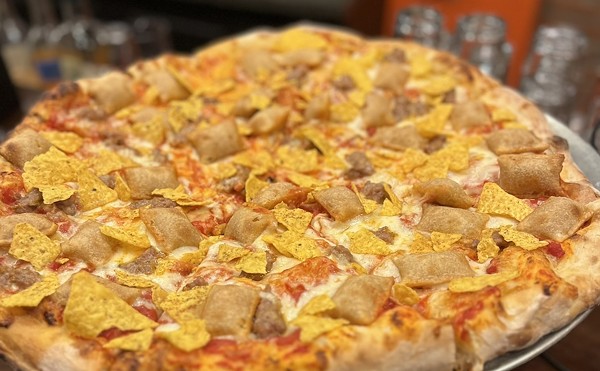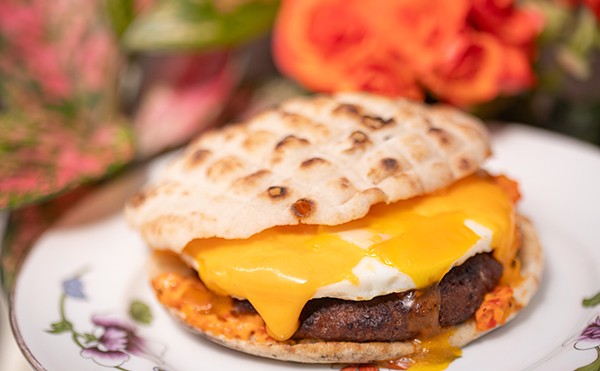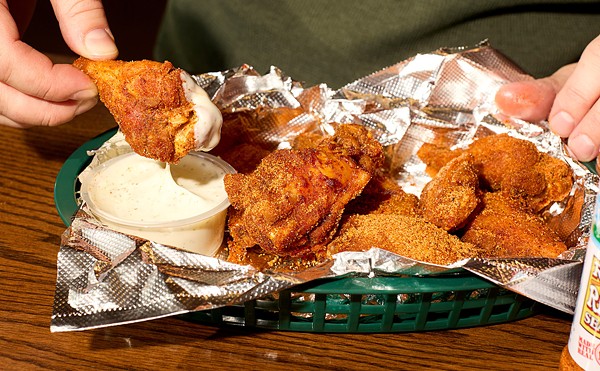You know who's enjoying this recession? Besides repo guys and Paul Krugman's booking agent? McDonald's. Profits are up as cash-strapped folks opt for the Dollar Menu and the $2 latte. While most of us spend our time praying we aren't next on the firing line, Ronald and Grimace are driving around town in an Escalade, tossing wads of cash at all the mewling urchins.
We can gnash our teeth about fast food and empty calories another time. From a business standpoint, it's utterly, icily logical: Give people more for less. You can't argue, let alone try to compete, with that.
Not that we should genuflect at the altar of the Golden Arches. I think there remains more than a few of us who, while more thrifty than we were a year ago, haven't eliminated our dining-out budget entirely — and who don't want to limit our choices to fast-food or chain restaurants. If so, then you can't argue with the logic of Sugo's Spaghetteria.
Sugo's is the latest venture from the Del Pietro family. The name conjures images of red-checkered tablecloths and candles in Chianti bottles, but this is no retro mom-and-pop joint. The location, in a small strip mall across Clayton Road from Plaza Frontenac, suggests something upscale, if not fancy, but Sugo's isn't that, either.
On my first visit, during a busy midweek lunch, my immediate impression is of warmth. The walls of the spacious dining room are painted autumnal shades of red and gold. The menu and by-the-glass wine list are written on chalkboards. From the partially exposed kitchen waft the aromas of baking bread and bubbling cheese. There's a steady buzz of conversation: businessmen with ties slung over shoulders, parents managing three kids and one pizza, ladies who lunch greeting old friends loudly and more subdued midday dates. Seated by myself near the front of the room, I feel awkward: Sugo's is a place to get together.
The warmth, I should note, is metaphorical. Sugo's front door opens directly into the dining room, which causes a draft on cold days.
My table is set, sort of: My utensils sit inside my empty water glass. This looks nifty from afar, but I check and then double-check that my utensils are clean before I pour water into the glass. Some other diners don't have the chance to check: Their servers slide their utensils onto their napkins and then fill their water glasses for them.
The menu is simple: a few appetizers — the bruschetta, spilling over with chopped tomato, is excellent — salads, pasta, pizza and a plate of the day. Today, because this is Sugo's Spaghetteria, and also because it looks impressive as servers whisk it to other tables, I order the spaghetti and meatballs.
This brings exactly two meatballs, each the size of a small orange, atop a mound of spaghetti in a thin red tomato sauce; shaved Parmigiano-Reggiano is scattered over the plate. The meatballs are excellent, their exteriors browned but not crusty, their interiors tender and flavorful. The seasoning is light — maybe some garlic, maybe some oregano — just enough to round out the ground beef's flavor. The sauce is sweet, but not sugary. It is, however, too oily.
Still, my attention is on those meatballs. Glutton that I am, though, I can't finish them. A more restrained diner could make two meals out of this. Not too shabby for a $10 entrée.
Same with the lasagna. For $10 you receive a slab of noodles, sausage and cheese that could easily serve two. The menu describes this as "housemade," but I think homemade is the more appropriate term. A semantic quibble? Maybe. But "housemade" is a term for pretentious restaurants, and what's charming about this lasagna is how unpretentious it is, hardly different from what you might make at home. The top has that irresistible crust of blistered, brown mozzarella; underneath a little ricotta and a lot of melting mozzarella surround sausage more sweet than spicy and soft, but not soggy, noodles. The only flourish? Once again, shaved Parmigiano-Reggiano.
There is a risotto of the day — though no server ever tells me what this is — as well as pasta with mushrooms, pasta tutto mare and chicken alfredo. Here Sugo's reveals its limitations. The menu is only as appealing as your predilection for a certain dish. The spaghetti and meatballs and the lasagna press my comfort-food buttons; these pastas don't.
I do experience the chicken alfredo — by proxy, anyway — when I return on a Wednesday and order the plate of the day, chicken spiedini. I choose it because it's the daily special, not because it's chicken spiedini. This is Italian-American food at its blandest: chicken rolled in bread crumbs and then sautéed, here served over spaghetti tossed in a cream sauce. The chicken had a decent texture, the exterior crisp and brown, but I don't exaggerate when I say the dish had absolutely no flavor.
Pizza is available with your choice of thin or medium-thick crust. The menu denotes these as Neapolitan and Sicilian, but this is more shorthand than anything else. True Neapolitan pizza must adhere to strict guidelines, while Sicilian pizza usually refers to (in Sicily) a pizza with ingredients baked into the crust or (in America) something akin to deep-dish pizza.
Neapolitan or "Neapolitan," I like Sugo's thin-crust pizzas. The crust is crisp but not burnt, with just enough body to stand up to a reasonable number of toppings. I try the traditional margherita: mozzarella, tomato, basil and olive oil. This could have used a few more tomato slices, but the mozzarella is fresh, and nearly every slice has a pocket where the cheese hasn't entirely melted. This provides a burst of flavor and a pleasant contrast in texture. True Neapolitan pizzas don't come with a plethora of toppings, and the "Sugo's" pizza suggests why. Topped with ground beef, sausage, bacon and pepperoni, the crust turns flimsy, and the pie, as a whole, is too greasy.
I'm less enamored of the "Sicilian" pizza, which I order plain. Sugo's makes a tomato sauce from crushed whole tomatoes. I approve of this in principle, but here the sauce is spread much too thin, especially given the thick layer of melted mozzarella, leading to something more like cheese bread than pizza.
The wine list is brief, but the by-the-glass selection does offer a few nice touches: a Chianti Classico in addition to the standard Chianti as well as a super- Tuscan. A telling detail: At $13, a glass of that super-Tuscan costs more than everything on the food menu except for a Sicilian pizza with toppings.
Will your final bill cost more than a trip to, say, McDonald's? Well, yes. But saving a few bucks and supporting a local business ought to be a key part of a happy meal.





